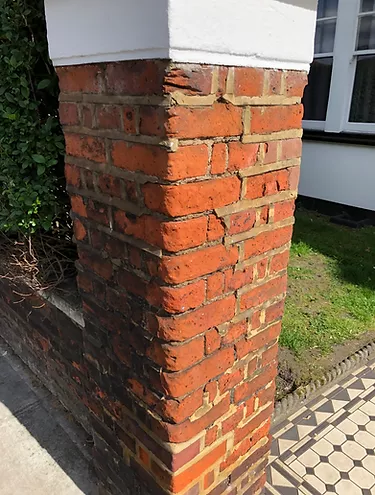‘Conservation is the process of maintaining and managing change to a heritage asset in a way that sustains and where appropriate enhances its significance’ – English Heritage
London Listed Building Surveys from Blackacre
Our Listed Building Surveys are bespoke surveys designed for heritage and Listed Buildings. They are based on our pre-purchase Building Surveys template but have been adapted to be more relevant for older buildings.
Heritage and Listed buildings behave differently from their modern equivalents. They have single-skin walls and softer permeable fabric.
Therefore, older buildings are, by their very nature, breathable. They allow for vapor permeability through the fabric. In comparison, modern cavity walls and impermeable cements are barriers to rainwater.
A classic metaphor, is the difference between a duffle coat and a raincoat. Both will keep you dry, but they do this in different ways. One gets wet and allows moisture to naturally evaporate back into the atmosphere. The other is impermeable and prevents water ingress and is also non-breathable.
There are over 6 million traditional buildings and over 500,000 listed monuments in the UK. As a result, building professionals need to understand the nature and practicalities of conservation.
At Blackacre we have extensive background learning, qualifications and experience.
We ensure that our traditional buildings are respected and understood so we can specify the best and most sympathetic repairs to maintain and even enhance their significance.
Key Contact
Ben Salvage MRICS C.Build E MCABE
Director
Chartered Building Surveyor
Chartered Building Engineer
07515 441468
ben.salvage@blackacresurveyors.com
What we do
- Listed Building Surveys (pre-purchase)
- Interim Condition Surveys
- Building Pathology Consultancy
- Timber & Damp Surveys
- Repair Schedules (Scope of Works)
- Project Management

What is a Listed Building?
A Listed Building in the UK is a structure that has been recognised as being of special architectural, historical, or cultural significance.
These buildings are protected by law under the Planning (Listed Buildings and Conservation Areas) Act 1990, meaning that they cannot be altered, extended, or demolished without special permission from the local planning authority.
Listed buildings are classified into three grades:
Grade I: Buildings of exceptional interest (only 2.5% of all listed buildings fall into this category).
Grade II*: Buildings of particularly important interest, with some special features that stand out.
Grade II: Buildings of national importance and special interest, making up the majority of listed buildings.
Listing status applies to the entire building, both interior and exterior, and can also include fixtures, outbuildings, or even boundary walls and fences.
Owners of listed buildings have a legal responsibility to maintain their property in a way that preserves its historic character. Any works, even seemingly minor ones, may require Listed Building Consent to ensure the building’s integrity is not compromised.
The aim of listing is to preserve the architectural and historical heritage for future generations.
It’s important to note that listing doesn’t mean a building is frozen in time, but it does require that changes respect the original character of the structure.
Buying a Listed building
Any heritage building has a certain romantic charm. Often described as ‘character’ and is a different experience to living in a ‘normal’ house. Because of this, many people are unwilling to deal with the imperfections that typically come with older houses. This includes sloping floors, low ceilings and draughty windows. However, if you are a period property person, they can be an exciting and highly rewarding venture.
Due to the nature of a Listed building, many elements and materials of the property are centuries old. As a result they will have experienced wear and general living over time. This itself, does not mean an element is defective and you should expect this type of condition when buying a Listed building.
Listed building legislation
When purchasing a Listed building you are buying something with ‘special architectural interest’. Although, you may own the property, it could be argued that you are effectively just a custodian of the building for your occupation. Careful considerations need to be made before jumping into a Listed building purchase, and so, these come with certain responsibilities and restrictions.
Although there is no direct legal obligation on an owner of a Listed building to carry out repairs. Local and central government can force repairs to be carried out using an ‘urgent works notice’, necessary for its preservation. If the works are not carried out by the owner, the authority has the power to enter the property. It can carry out the works and seek to recover the costs from the owner.
If you want to carry out any alterations which may impact on the character or appearance of the building (internally or externally), you will need to get Listed Building Consent. Otherwise it is a criminal offence to do this type of work. This can involve anything from knocking through an internal partition wall, removing a chimney breast, or even changing new uPVC windows for traditional timber ones.
Alteration or repair?
Consent is not normally required for repairs (providing they are like-for-like) to a Listed building. However a clear distinction between whether the work is an alteration or a repair must be established. You should always talk to the local Conservation Officer and run through proposed works with them.
Examples of alteration works that would require Listed Building Consent would be: repointing walls in modern cement; replacement of windows; rendering the external walls with modern cement render or removing old lime renders.
Past repair liability
Unfortunately, there are many surveyors, architects and builders that are not trained in conservation. They don’t understand heritage buildings, how they work or the need for specific repairs to maintain the integrity of their fabric.
Too often we see beautiful Listed properties that have been damaged by quick repairs using modern, non-porous materials. This does mean that in some instances some previous repairs will need to be removed to sustain integrity. One such example of poor repairs, is the use of modern cement to re-point older, softer brickwork, which can cause ‘spalling’ to the brick face.
In conclusion, some purchases of Listed buildings can come with a considerable liability to put things right. You should get a specialist building surveyor to report on the condition of the property and its potential liabilities.
Lime Mortar
Up until about the 1920's lime mortar was generally used for a range of applications. For instance, it was used in construction of houses such as laying masonry, external render and internal plaster. For solid brickwork structures with a single leaf, this was beneficial as it was soft and porous, allowing the structure to breathe. Walls would get wet and the soft lime mortar would act as a channel for water to evaporate freely. This in turn can cause damage to the mortar, slowly degrading it over time, which is why it is sometimes referred to as being 'sacrificial'.
Now, with cavity wall construction modern cement is used which is non-porous and non-breathable. This allows for rainwater to be repelled from the wall surface (like the raincoat example, as explained in the About section above).
This works for modern construction. However too often we see cement repairs on old solid walled buildings that require lime mortar. This means that the channel of water evaporation is directed through the brickwork. This causes damage and the need for repairs.

Lime Putty & Natural Hydraulic Lime (NHL)
The manufacture of lime was undertaken using a kiln. This would be fired and Calcium Carbonate (limestone or chalk) to around 900 degrees. This heat would omit Carbon Dioxide and produce Calcium Oxide (quicklime). Once mixed with water (slaked) this would produce a lime putty that could be mixed with an appropriate sand for pointing.
There are various types of lime mortar, lime putty, hot lime, natural Hydraulic Lime (NHL) 2, 3.5 and 5. These can be used and varying degrees of hardness suitable for different wall materials and uses.
Timber Frame Buildings
Before the use of bricks became commonplace as a building material, a timber frame was the main method of providing structural rigidity. It enabled strength and a habitable space which could support a roof.
A network of timbers transfers load to the ground via a timber skeleton. This can be in a variety of formations, often changing with region and over time period. Box frames, post and truss, cruck are all types of timber cross frames used throughout history.
Breathability is a fundamental requirement with timber buildings. They must be allowed to shed moisture to avoid prolonged dampness. This will cause the onset of rot, decay and attract beetle.

Common Problems
Too often we find beautiful timber frame buildings that have been standing, living and breathing for centuries, but now are being damaged by incorrect materials, repairs or neglect. If correctly maintained with the correct breathable materials, there is no reason why these structures cannot continue standing for centuries more.
The common issue we find on our timber frame building surveys, is damp and the problems it brings. Whether it be high ground levels, exterior vinyl paint or modern infill panels and renders, there can be many reasons for excessive moisture to become trapped and build up.


Typically, the original infill panels will have been either removed or rendered over. This will have been done using modern non-breathable materials such as a cement render. Older building fabric needs to be treated as delicate. Newer, harder materials of today have the effect of locking in moisture into timber. After that it will accumulate and degrade materials.
Another common issue we find is rotten sole plates. This could be due to high ground levels or poor maintenance to rainwater goods. The sole plate is a critical element of the structure. It distributes the point load from the post uprights, to a plinth below, usually of stone or brick. A full investigation of the mortise and tenon joints between the sole plate and post is important. These joints can trap moisture and these will have to be remade to maintain structural integrity.
Do You Need a Listed Building Survey for Your London Property?
A professional Listed Building Survey ensures the proper conservation and maintenance of your heritage property, identifying issues like damp or inappropriate modern repairs.
Get expert advice tailored to London’s unique listed buildings and protect your investment.
Contact us today to arrange a thorough survey and receive a detailed report on the condition and preservation needs of your property.
Call us: 0203 476 9561
Email: info@blackacresurveyors.com
